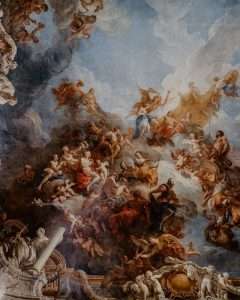I can’t get enough of it. The colors, the shapes, the motifs, the textures; the way they are made and what they are used for; their history…it all fascinates me. I have always been drawn to tribal art but have had a hard time exploring deeper into the subject. Now I am excited to share with you 12 reasons why tribal art is becoming more and more popular these days and why I’m so infatuated with it.
Tribal art includes arts from peoples around the world who still retain traditional skills and techniques. As you will see from this list, tribal arts encompass a wide variety of unique artistic mediums including masks, jewelry, hand painted textiles, pottery and much more!**
Tribal art is becoming increasingly popular as a decorative home accessory and as a subject for photography. But what are some of the reasons behind this trend? Is it just a fad or is it here to stay?
As a child growing up in the rural Midwest, I was both drawn to and repelled by tribal art. The overall designs were often so complex that they boggled my mind, and yet the images themselves were often sacred and taboo.
Tribal art, to me, was a window into an entirely different world and culture. It was something of tremendous interest and beauty, but also something that I knew I could never truly understand.
Today, tribal art is becoming far more accessible to those who are interested in it. You no longer have to travel back in time or across the world to see works of art that were created thousands of years ago or more. You can find them in museums and galleries around the country. You can even find them for sale online!
As with any work of art, you may not always enjoy what you see when you look at tribal art. However, there are many reasons why tribal art has become more popular over the years, giving us plenty of excellent reasons why we should all appreciate it.
1) Tribal art has a long history of being admired by highly regarded individuals. This includes monarchs, popes, intellectuals and great artists such as Picasso, Matisse and Warhol.
Tribal art was once considered more valuable than contemporary western art – and some would argue that it still is. Take the example of Picasso’s The Dream, which was acquired by the Metropolitan Museum of Art in 1937 for $50,000 (currently equivalent to $947,600) – an incredible amount of money at the time!
2) Tribal art can be found in many world-renowned collections. For example: The British Museum, The Fitzwilliam Museum in Cambridge, The Tate Gallery and the Metropolitan Museum of Art in New York also have substantial collections. Further still, institutions such as Sotheby’s will auction tribal art from time to time – with pieces often selling for millions of dollars.
3) Tribal art allows us to see into a part of human life that we are only ever rarely privy to – the lives of those who lived thousands of years ago. Through studying tribal art we gain an understanding into how people used to live and what their beliefs were.
4) Many people consider tribal art to be a form of high quality
So what happened? Where did this tribal art come from and why is it so powerful now? It is important to note that the word “tribal” is a misnomer. Tribal art was not produced by tribes of people. It was produced by people who lived in villages and towns and cities, but who belonged to tribes.
Tribal art is often mistakenly thought of as “primitive,” but this is incorrect. To suggest that tribal art is primitive suggests that it lacks sophistication or elegance. Nothing could be further from the truth. The artist creates with a level of skill and technique that surpasses many modern artists. The materials used are not always the most sophisticated either. The pigments used by the artist might be derived from clay or plant matter, but they are often mixed with animal fat and ground to a fine powder using stones or bones to create a paint that is as vibrant and permanent as any manufactured in a tube today.
The power of tribal art lies in its spirituality. It represents the belief systems of many ancient cultures, particularly those societies without writing systems, who used art as a way to communicate their beliefs through symbolism and ritual practices. The rituals of these societies were performed in an attempt to influence natural forces (such as weather, disease,
What makes tribal art so unique is its rich history. Tribal art isn’t an imitation of Western artwork. It’s a representation of culture and heritage. Each piece of tribal art tells a story about the artist, the tribe, and the location in which it was made. Tribal art can be found throughout many cultures but remains particularly popular among Asian, African, and South American communities.
Artists who create this type of work are often called “tribal artists” or “primitive artists.” They use a variety of materials to complete their pieces, including beads, metal, bones, leather and stone. The types of artwork you’ll find vary greatly depending on the materials used and the region in which they were created.
__*Hand-painted pottery
__*Weaving
__*Woodwork (including masks)
__*Jewelry making
__*Blanket weaving
__*Sculpture
Tribal art is typically used for trade or cultural exchange. Items are often given as gifts during special occasions like birthdays or weddings. Some tribal art items are even considered family heirlooms that are passed from generation to generation within one family or tribe.
“Tribal Art” is a category of art that encompasses the works of indigenous peoples. The term was coined by Western anthropologists from the late 19th century to identify the art of non-Western cultures.
The styles often have descriptive names, such as “Zulu basketry,” but the term “tribal” tends to connote authenticity and exoticism, which are characteristics sought by Western collectors.
There are many types of tribal art, and it is not a style but rather an artistic tradition that crosses cultures. The distinctive features vary from culture to culture: what is tribal in one place may be conventional in another. Tribal art is also not restricted to the work of uncivilized or preliterate peoples: technically advanced cultures often produce tribal art.



